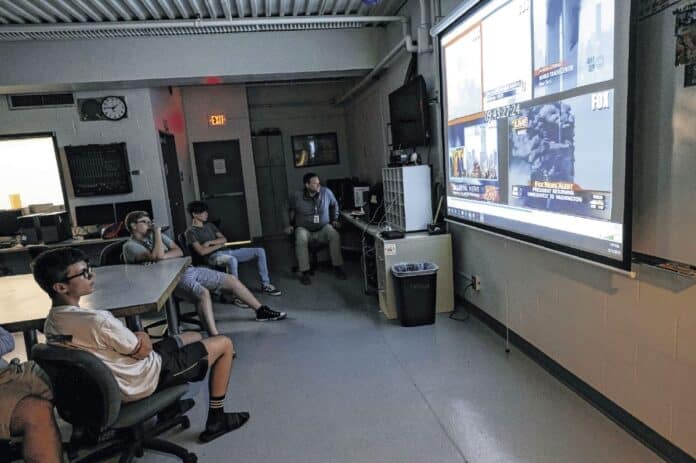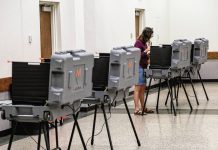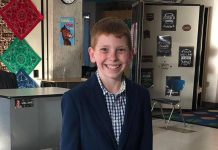
Sept. 11 is Jim Roeder’s favorite day to teach his broadcast courses at Columbus East High School.
Not because it’s a fun class, he said, but because he gets to teach students about what the media does and what the media did in response to the horrific events that unfolded in New York City, Washington D.C. and Shanksville, Pennsylvania, on that day in 2001.
“To me, this is the most defining moment in media history,” Roeder told his students Wednesday. “It’s certainly the most defining moment in the way the media understands its audience.”
Roeder created a special lesson plan ahead of the 18th anniversary of the 9/11 terrorist attacks to teach students about the media’s role in reporting the story as it happened, second-by-second. In a 29-minute video, Roeder syncs up five major news outlets’ coverage with one another on one screen to show how each outlet — NBC, CBS, ABC, CNN and FOX — covered the event.
[sc:text-divider text-divider-title=”Story continues below gallery” ]Click here to purchase photos from this gallery
“This video is a lot to digest,” Roeder said.
It begins with audio of news anchors from all five networks talking simultaneously and each displaying a live shot of the Twin Towers after Flight 11 struck the North Tower at 8:46 a.m. Just minutes into the video, cameras capture Flight 175 crashing into the south face of the South Tower at 9:03 a.m.
The minutes that follow felt like hours as Flight 77 crashes into The Pentagon at 9:37 a.m., the South Tower collapses at 9:59 a.m., Flight 93 crashes into a Pennsylvania field at 10:03 a.m. and the North Tower collapses at 10:28 a.m.
The students in Roeder’s class are too young to remember the events that occurred on Sept. 11, 2001 — most hadn’t even been born yet. Still, they had lots of questions about the day.
Senior Liberty Mahoney was 2-months-old when America was attacked on its own soil. She was at home with her mom and sister, and her dad was a teacher at Seymour High School. What was a normal school day immediately shifted as every eye in the school building was glued to television screens.
While she doesn’t remember that day herself, Mahoney said she’s been exposed to several lessons throughout her school career that keep the day fresh in her mind.
“The history behind it, the fact that I was born the same year this happened, it’s crazy to think I essentially lived through this,” Mahoney said. “To go back and watch it, to just dissect it and truly understand what happened that day, it’s mind-boggling.”
For the entire duration of the 29-minute video shown in Roeder’s class, each students’ eyes were glued to the TV as if they were watching it in real time, just as Mahoney’s father and his students did on the same day 18 years earlier.
Roeder paused the video multiple times throughout to discuss the methods and tactics that media networks used to report the story to viewers.
Roeder can still recall the panicked phone call from his wife telling him to turn on the Today Show just before 9 a.m. as he was packing for a trip to Nuremburg, Germany, where he was set to cover an IndyCar race for ESPN. He would be boarding a flight to Germany that same day.
“She says, ‘Something’s going on and it looks really big, and I’ve only seen it in a patient’s room,’ and she hangs up,” Roeder said. “I turn the TV on, I watch for a couple minutes, I see the second plane hit and I continue packing because at this point it’s really not that big of a deal to me.”
At about 10 a.m., Roeder gets a call from ESPN saying all ESPN personnel are grounded. Roeder called his mother, who worked at the Bank One Tower in Indianapolis — the tallest building in Indianapolis — and told her to go home.
“The last thing I wanted was my mom to be in the tallest building in Indianapolis at the time — we didn’t know what was happening,” Roeder said.
Senior Max Turnbow said he is reminded of 9/11 often, especially when the anniversary comes around because his stepfather is a firefighter who had friends sent to New York City to respond.
When he traveled to Washington D.C. on the eighth grade field trip, he remembers seeing the spot where the plane crashed into The Pentagon, recalling the different colored bricks where the building was repaired.
“It’s difficult to see this,” Turnbow said. “We see World War II in our history books, and I think the most recent tragedy the world had seen on that big of a scale before 9/11 was World War II. For our generation, that’s our great grandparents. With 9/11 being so recent, this was our parents. We were born right after it, but it still affects us.”
[sc:pullout-title pullout-title=”Where to learn more” ][sc:pullout-text-begin]
Students in grades K-12 don’t remember the Sept. 11 terrorist attack — they weren’t born yet.
A new HBO documentary, debuted on the event’s 18th anniversary, teaches youth about the tragic events that unfolded on that day. "What Happened on Sept. 11" is aimed generally at children ages 7 to 12 and will be made available to schools for free, along with a curriculum being developed.
"What Happened on September 11" is directed and produced by Emmy-winner Amy Schatz in collaboration with the 9/11 Tribute Museum.
The half-hour film is available for streaming at hbo.com/documentaries/what-happened-on-september-11.
[sc:pullout-text-end]




